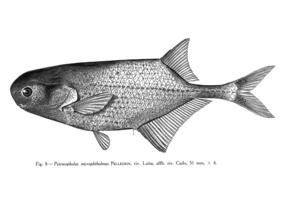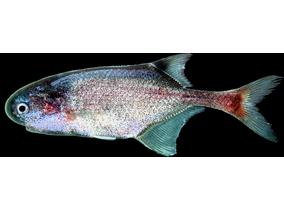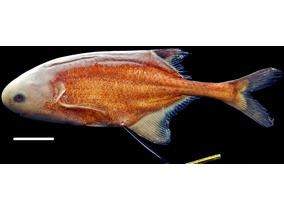You are here
Mormyridae
Petrocephalus microphthalmus Pellegrin 1908
Nomenclature
-
Subfamily: PetrocephalinaeGenus: Petrocephalus
Media
SUMMARY
Petrocephalus microphthalmus is a small (possibly the smallest) species of Petrocephalus (larger specimen ever collected = 73.7 mm standard length). Body ovoid, body 2.6-2.8 longer than high and laterally compressed. Head length between 3.8 and 4.0 times in standard length. Snout short and round. Mouth small (3.6 ≤ head length/mouth width ≤ 4.2, holotype = 3.8), opening under the eye. Teeth small and bicuspid, 9–11 (holotype = 10) in a single row in the upper jaw, 14–20 (holotype = 20) in a single row in the lower jaw. Dorsal and anal fins originate in the posterior half of the body (standard lengthp/pre–dorsal distance = 1.5 and standard length/pre–anal distance = 1.7). Pre–dorsal distance slightly greater than pre–anal distance. Dorsal fin with 16–18 branched rays (holotype = 16). Anal fin with 25–27 branched rays (holotype = 25). Scales cover the entire body, except for the head. Lateral line visible and complete with 34 to 36 pored scales along its length (holotype = 36). Eight to 10 scales between the anterior base of the anal fin and the lateral line. Twelve scales around the caudal peduncle. Skin on head thick, becoming opaque with formalin fixation, containing numerous Knollenorgan electroreceptors which do not form "rosettes" in their typical positions. Instead, Knollenorgans appear as isolated receptor pores in the skin covering the head, the character state observed in the Mormyrinae.
Body generally blue–gray, with the dorsum darker than the abdomen. Numerous chromatophores occur below the skin surface. This species can appear metallic blue to violet depending on the angle and intensity of illumination. The color is especially intense on the operculum. The fins are translucent except for the first dorsal fin rays, which are black near their insertion.






